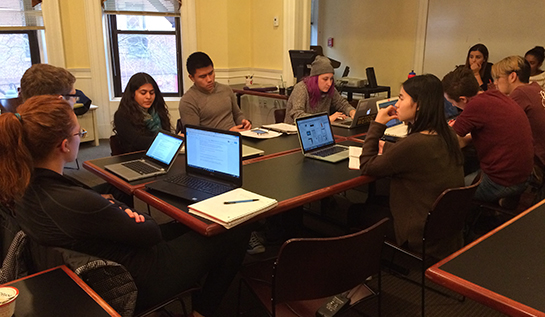Classroom Spotlight: ‘India and the World’
In reality, the border between the nations of India and Pakistan is a fraught place, filled with challenges for those who wish to travel or live safely. But according to students at the Pardee School, a way forward for the embattled region may be found through improvements in trade.
That was the conclusion of students in ‘India and the World,’ one of the many classes at the Frederick S. Pardee School of Global Studies at Boston University that is consistently informed by current events. In the case of India, its border with Pakistan is a constant driver of news and geopolitical strife; one of the few borders in the world that can be seen from space, it played host just this November to the largest military exercise in Indian history.
How to reduce tensions along this divide was the goal of the end-of-semester simulation run by students in ‘India and the World,’ under the instruction of Prof. Manjari Chatterjee Miller.
“The goal was to come up with a 10 year plan to reduce tensions along the border through mediation. The class was divided into teams of India, Pakistan, Kashmir, and mediators,” Chatterjee Miller said.
The simulation was moderated by student Julie George, a BA/MA candidate in Political Science and English.
“Before the simulation, I was apprehensive about discussing Kashmir, particularly because of how divisive and rooted the issues are between India and Pakistan. To prepare for the simulation, I re-read articles were assigned during the semester to give us an understanding of several complexities within the Kashmir issue,” George said.
In total, nearly a dozen students participated, and Miller said that the single point of agreement was that there should be an increase in trade infrastructure across the heavily militarized border.
Another student, Minyoung Kim, played the part of Pakistan delegate in the simulation.
“What I thought most interesting was, we started the simulation with broad issues like independent Kashmir and terrorism, but we ended up with one resolution that was on cultural and economic exchange over the Line of Control. I found it almost impossible to reach an agreement relating to central controversies like independence or state-sponsored terrorism, because we all had mutually exclusive stakes in the such issues,” Kim said. “I thought this showed how hard it is to overcome the fundamental limits of compromise, and that what may seem like insignificant bilateral agreements like cultural exchanges could actually mean a big step forward.”
“I felt that I gained a newfound appreciation for how powerful negotiations can be. To have delegations from India, Pakistan, and Kashmir be represented by my peers was very interesting because we truly took on the ambitions of each side,” George said. “Although the delegations only supported one point of increased trade over the Line of Control, I felt that the simulation taught us how Kashmir is just more than a territorial conflict between two countries. This simulation was very eye-opening on a significantly important issue that plagues both India and Pakistan still to this very day.”
To suggest a class for an upcoming Classroom Spotlight, email the Pardee School.
